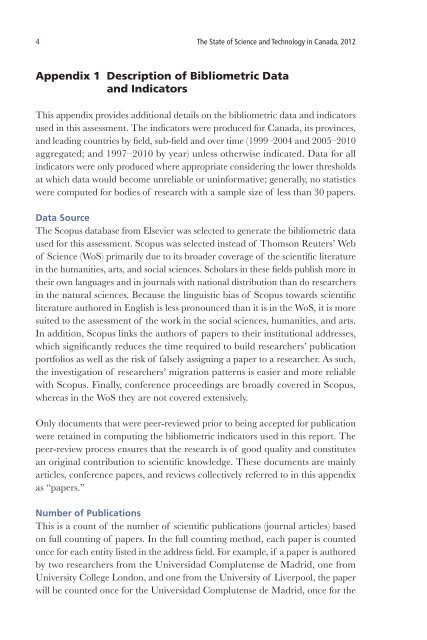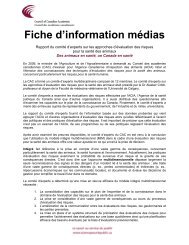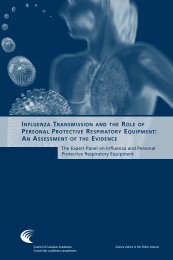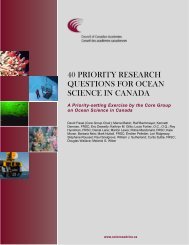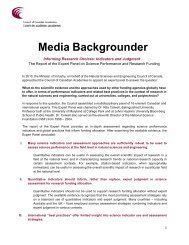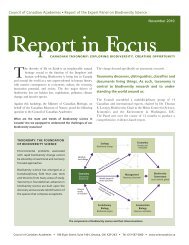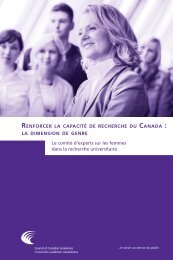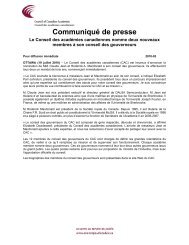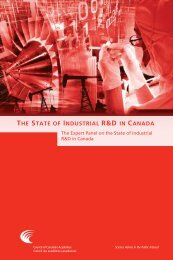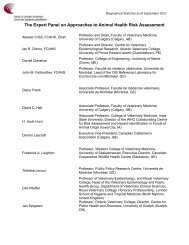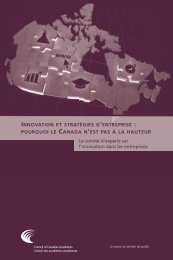IN CANADA, 2012 Appendices - Council of Canadian Academies
IN CANADA, 2012 Appendices - Council of Canadian Academies
IN CANADA, 2012 Appendices - Council of Canadian Academies
Create successful ePaper yourself
Turn your PDF publications into a flip-book with our unique Google optimized e-Paper software.
4 The State <strong>of</strong> Science and Technology in Canada, <strong>2012</strong><br />
Appendix 1 Description <strong>of</strong> Bibliometric Data<br />
and Indicators<br />
This appendix provides additional details on the bibliometric data and indicators<br />
used in this assessment. The indicators were produced for Canada, its provinces,<br />
and leading countries by field, sub-field and over time (1999–2004 and 2005–2010<br />
aggregated; and 1997–2010 by year) unless otherwise indicated. Data for all<br />
indicators were only produced where appropriate considering the lower thresholds<br />
at which data would become unreliable or uninformative; generally, no statistics<br />
were computed for bodies <strong>of</strong> research with a sample size <strong>of</strong> less than 30 papers.<br />
Data Source<br />
The Scopus database from Elsevier was selected to generate the bibliometric data<br />
used for this assessment. Scopus was selected instead <strong>of</strong> Thomson Reuters’ Web<br />
<strong>of</strong> Science (WoS) primarily due to its broader coverage <strong>of</strong> the scientific literature<br />
in the humanities, arts, and social sciences. Scholars in these fields publish more in<br />
their own languages and in journals with national distribution than do researchers<br />
in the natural sciences. Because the linguistic bias <strong>of</strong> Scopus towards scientific<br />
literature authored in English is less pronounced than it is in the WoS, it is more<br />
suited to the assessment <strong>of</strong> the work in the social sciences, humanities, and arts.<br />
In addition, Scopus links the authors <strong>of</strong> papers to their institutional addresses,<br />
which significantly reduces the time required to build researchers’ publication<br />
portfolios as well as the risk <strong>of</strong> falsely assigning a paper to a researcher. As such,<br />
the investigation <strong>of</strong> researchers’ migration patterns is easier and more reliable<br />
with Scopus. Finally, conference proceedings are broadly covered in Scopus,<br />
whereas in the WoS they are not covered extensively.<br />
Only documents that were peer-reviewed prior to being accepted for publication<br />
were retained in computing the bibliometric indicators used in this report. The<br />
peer-review process ensures that the research is <strong>of</strong> good quality and constitutes<br />
an original contribution to scientific knowledge. These documents are mainly<br />
articles, conference papers, and reviews collectively referred to in this appendix<br />
as “papers.”<br />
Number <strong>of</strong> Publications<br />
This is a count <strong>of</strong> the number <strong>of</strong> scientific publications (journal articles) based<br />
on full counting <strong>of</strong> papers. In the full counting method, each paper is counted<br />
once for each entity listed in the address field. For example, if a paper is authored<br />
by two researchers from the Universidad Complutense de Madrid, one from<br />
University College London, and one from the University <strong>of</strong> Liverpool, the paper<br />
will be counted once for the Universidad Complutense de Madrid, once for the


